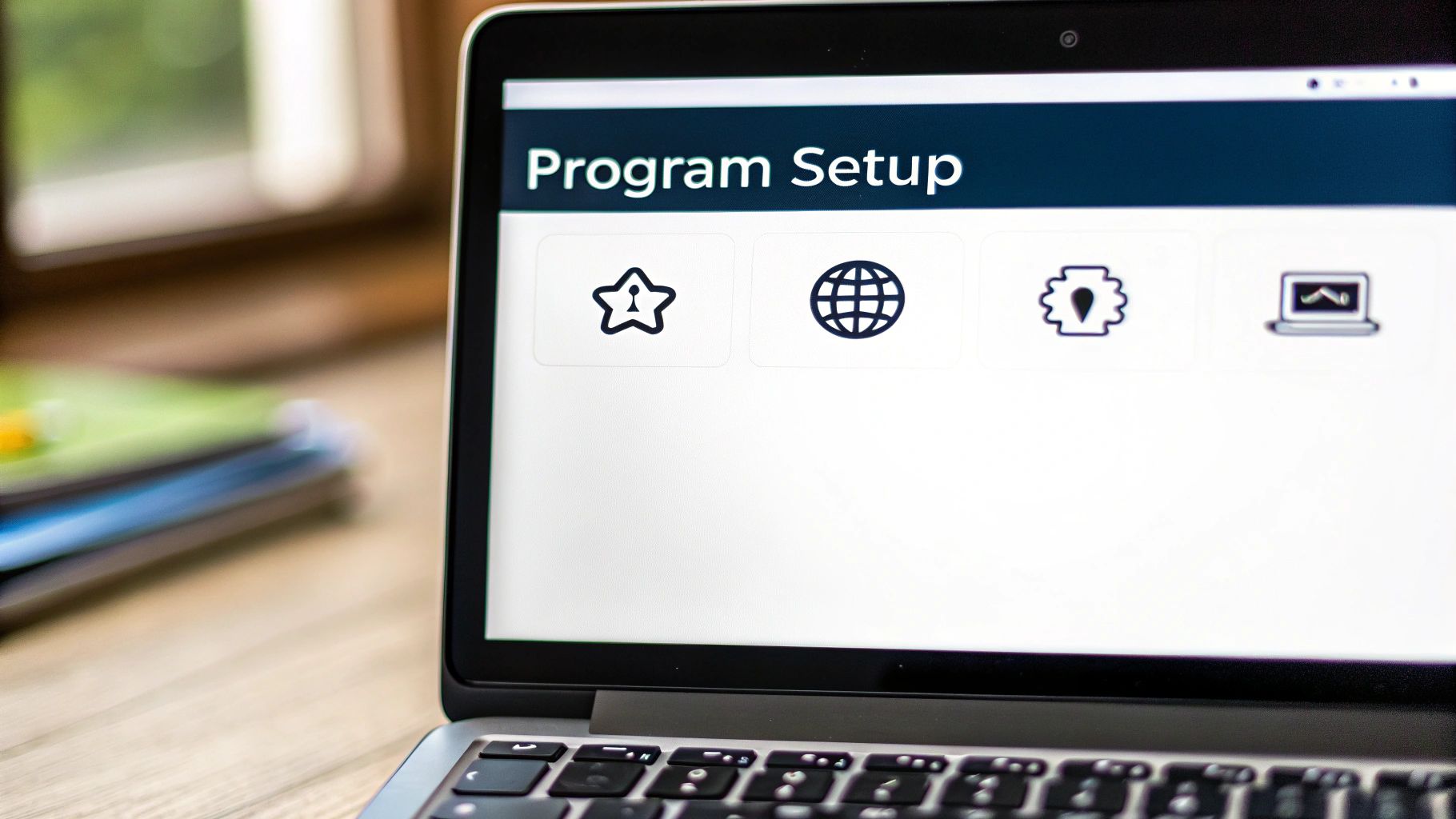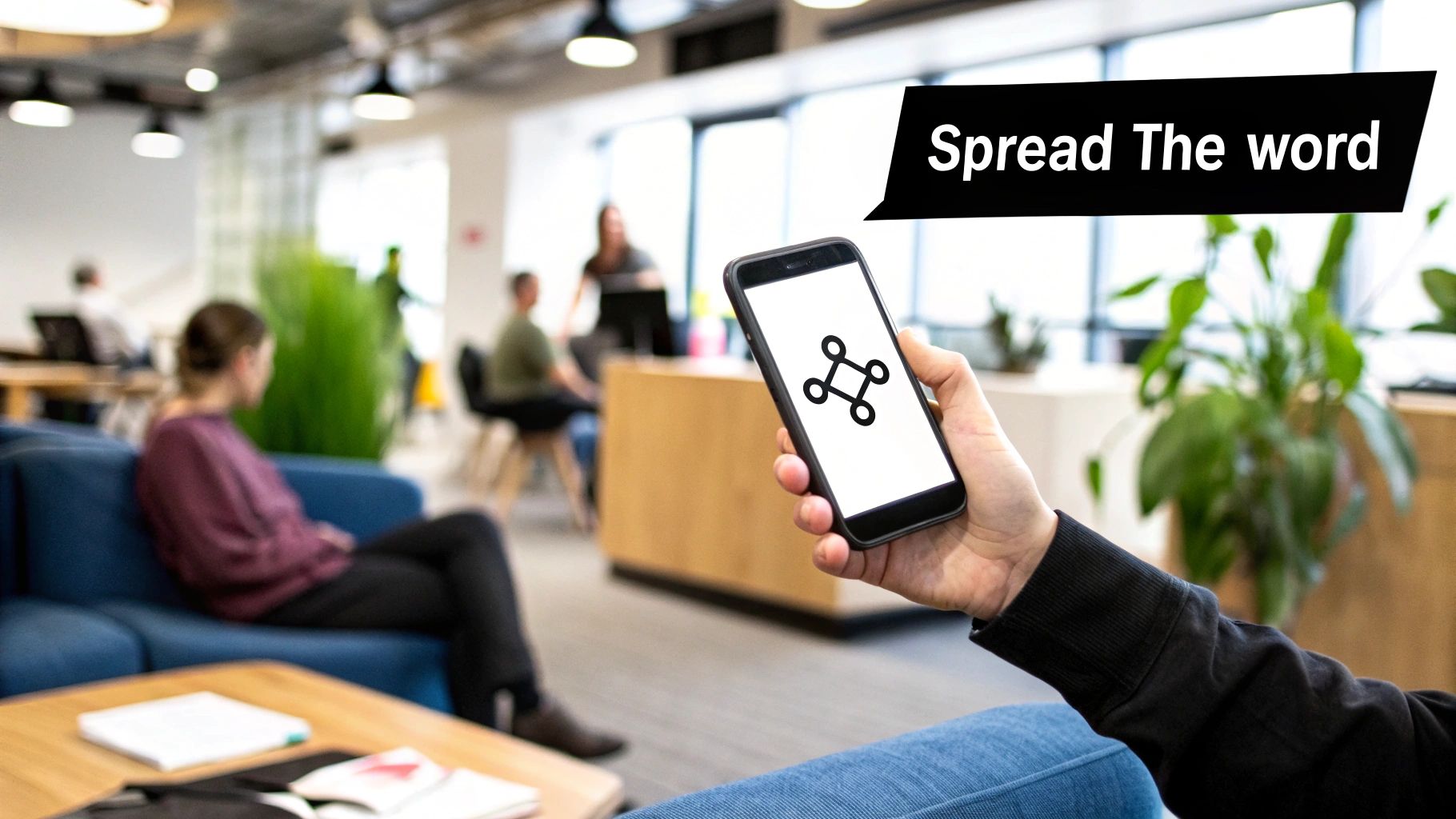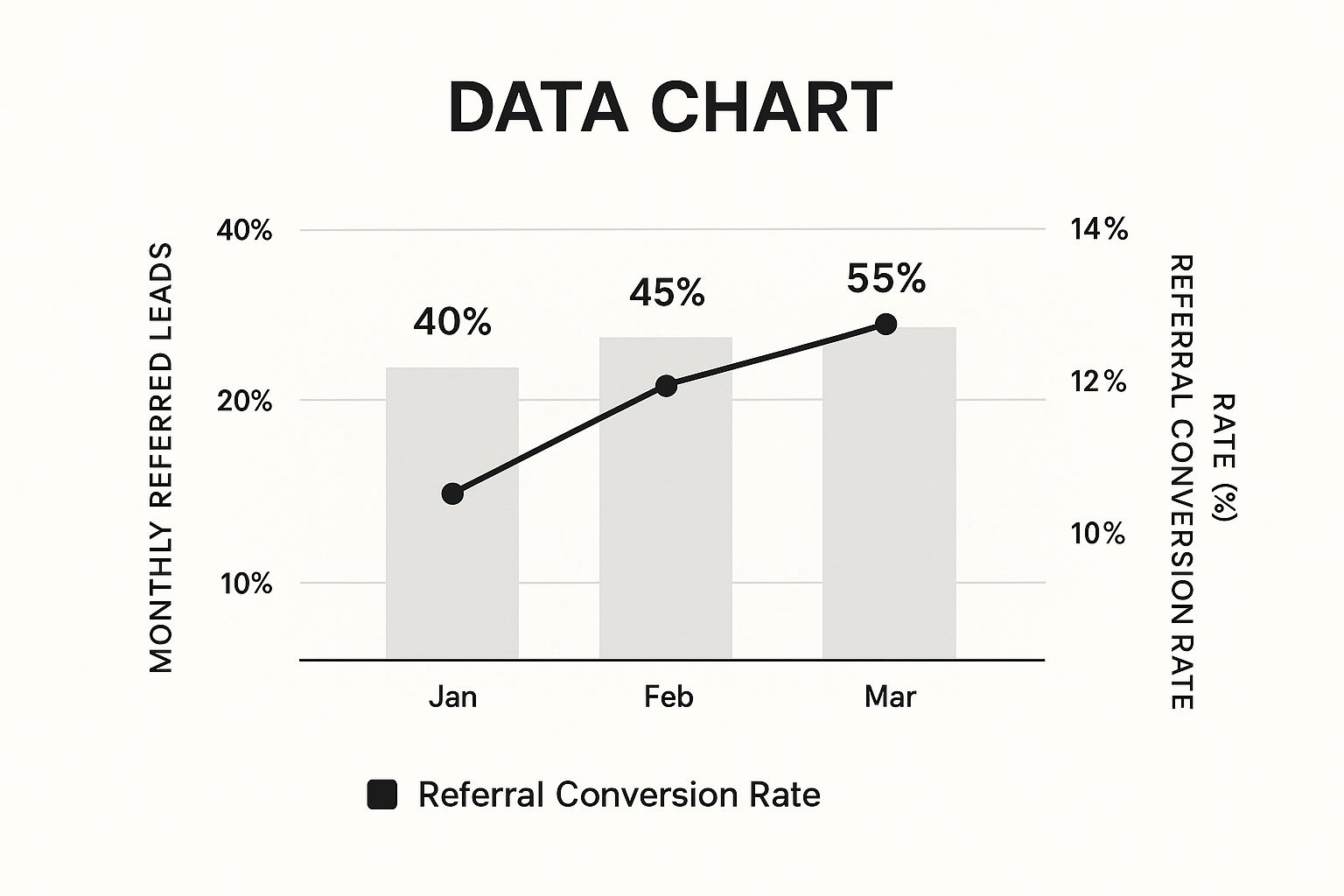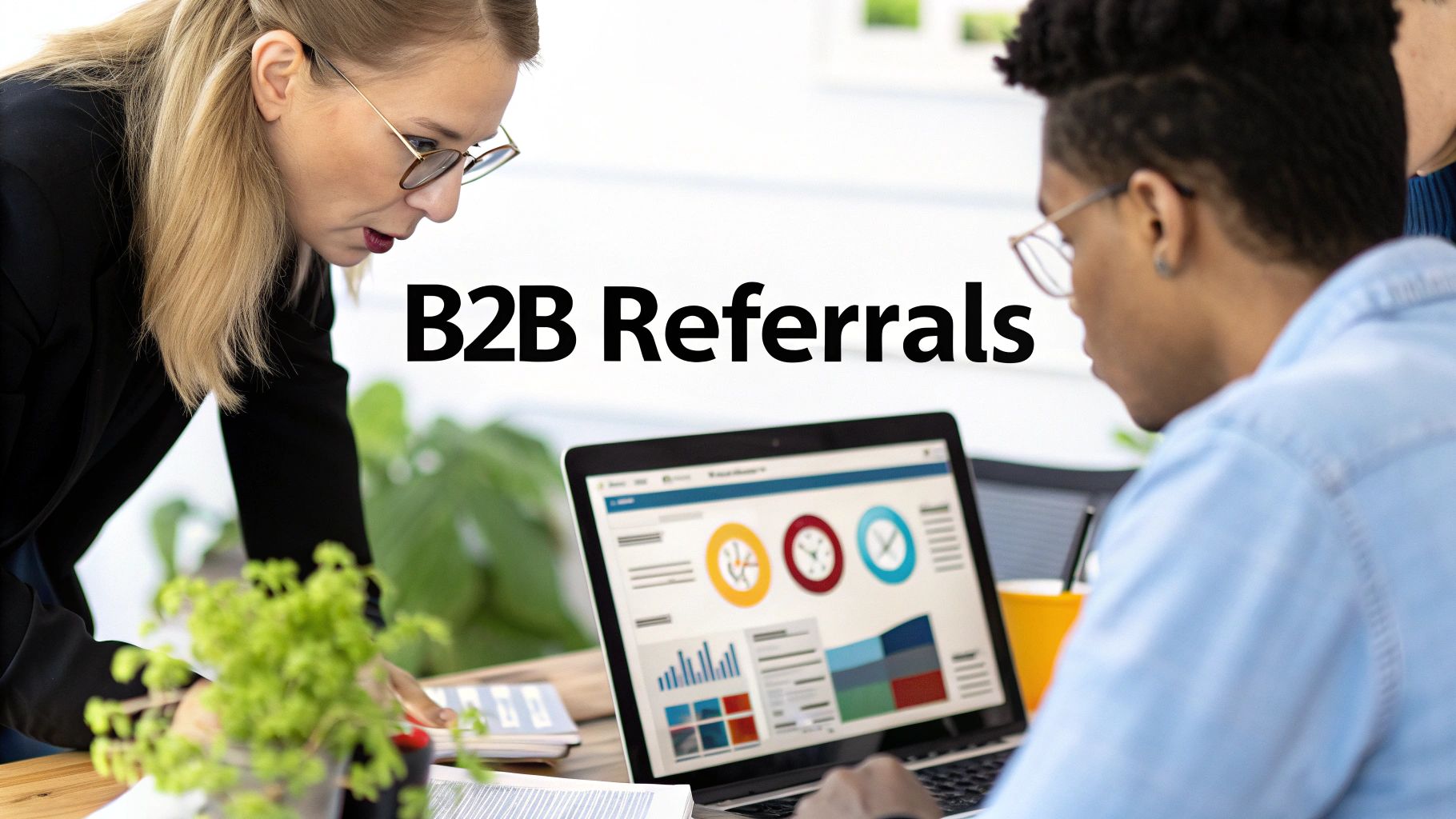Think of a B2B referral program as a way to formalize and supercharge the recommendations that might already be happening organically. Instead of just hoping for the occasional word-of-mouth nod, you're building a dedicated sales channel that actively encourages and rewards your best customers for sending new business your way.
This isn't just about getting more leads; it's about getting smarter leads. These are pre-qualified, high-intent prospects who arrive with a built-in layer of trust, leading to faster sales cycles and better conversion rates.
Why Your Best Customers Are Your Best Sales Team
Let's set aside cold outreach for a minute. What if your happiest, most successful clients became your most powerful and genuine sales team? That’s the real magic behind a well-designed B2B referral program. It’s about moving beyond wishful thinking and creating a predictable, scalable engine for growth.
The secret sauce is trust. In the B2B world, where buying decisions are high-stakes, a recommendation from a peer is the ultimate seal of approval. It cuts through the marketing noise in a way no case study or sales pitch ever could. When a trusted colleague vouches for a solution, it's not just a lead—it's a warm introduction.
Shifting from Chance to Strategy
Relying on informal, random referrals is like hoping to catch lightning in a bottle. It's fantastic when it happens, but you can't build a reliable growth strategy on it. Formalizing the process is what turns these one-off wins into a consistent, predictable source of high-quality leads.
A structured program gives your customers a clear, easy way to make referrals and a compelling reason to do so. You’re removing the friction and guesswork, empowering them to become true advocates for your brand. And the results speak for themselves. In fact, 86% of companies with a formal referral program saw revenue growth over the past two years, compared to just 75% of companies without one. You can dig into more of these B2B referral statistics over at Referral Rock.
It’s easy to see why a structured program outperforms a more passive approach. Let's break down the key differences.
| Attribute | Why It Matters in B2B |
|---|---|
| Scalability | A formal program can be scaled with your business, while informal word-of-mouth is unpredictable and limited. |
| Measurability | You can track every referral, measure ROI, and optimize performance—something impossible with random recommendations. |
| Motivation | Clear, tangible incentives encourage consistent participation, rather than leaving it to your customers' goodwill. |
| Visibility | It keeps your brand top-of-mind, prompting customers to look for referral opportunities they might otherwise miss. |
| Control | You guide the process, ensuring your brand message is communicated accurately and professionally. |
Simply put, a formal program gives you the controls to build a repeatable revenue stream.
A referral isn't just a lead; it's a relationship transfer. The trust your customer has built with their network is extended to you, giving your sales team an unparalleled advantage from the very first conversation.
This strategy doesn’t just bring in more leads—it brings in the right kind of leads. Referred customers tend to have a higher lifetime value (LTV) and stick around longer. Why? Because they start the relationship with a solid foundation of trust and a clear understanding of the value you provide, setting the stage for a true partnership.
Designing Your Program's Core Framework
A great B2B referral program doesn't just happen. It's built on a solid, well-thought-out framework that aligns perfectly with your business goals. Getting this right from the start is what separates the programs that fizzle out from the ones that become a consistent source of high-quality leads. This is all about setting the rules of the game.

First things first, who can actually send referrals your way? The obvious answer is your happy customers, and they should absolutely be your primary focus. But don't stop there. I've seen companies find incredible success by thinking bigger and expanding their pool of advocates.
Consider opening up your program to:
- Channel Partners: Think about other businesses that serve your ideal customer but aren't direct competitors. They're a natural fit.
- Industry Influencers: Getting respected voices in your niche on board can add a massive layer of credibility.
- Past Customers: Just because they're no longer a client doesn't mean they didn't have a great experience. A positive memory can easily turn into a valuable lead.
Each of these groups might need a slightly different approach, but widening your net like this can dramatically increase your program's reach from day one.
Defining a Qualified Referral
This is where clarity is king. If your rules are fuzzy, you’ll create confusion and frustration, which is the fastest way to kill a referral program. You need a rock-solid definition of what a "qualified" referral actually is. This is your quality control—it protects you from chasing dead-end leads and ensures you’re only paying out for real business growth.
For example, a SaaS company might define a qualified lead as someone from a company with over 50 employees who actually sits through a full product demo. A marketing agency might only count a referral once a contract is signed for a project over a certain value. Get specific and make sure these rules are front and center.
Your program's rules should be simple enough to explain in 30 seconds. If they're too complex, potential advocates will disengage before they even start sharing.
This same need for clarity applies to your reward structure. Who gets the reward? You have two main options: a single-sided model, where only the person referring gets something, or a double-sided model, where both the referrer and their friend benefit.
If you want to dive deeper into these foundational elements, our guide on building a referral program breaks down how to structure these rules for the best results.
Choosing Your Incentive Model
The choice between single and double-sided incentives really gets to the heart of what motivates people. While a single-sided reward can certainly work, I've found that the double-sided approach is almost always more effective in the B2B world. Why? It reframes the referral from "I'm trying to get something" to "I'm giving you something valuable."
Let’s look at how this plays out:
- Single-Sided: Your customer gets a $200 gift card when their referral signs up. It’s a clean, simple motivator.
- Double-Sided: Your customer gets a $150 gift card, and the new client they referred gets 10% off their first-year subscription.
That second option is powerful. It arms your advocate with a genuine benefit to pass along, making the introduction feel less like a sales pitch and more like a helpful tip from a trusted colleague. This little bit of social currency often boosts conversion rates because the new lead has an immediate reason to take the next step. Your final choice should reflect what your brand stands for and what truly drives your customers, setting the stage for a truly successful referral program b2b.
Crafting Incentives That Truly Motivate Professionals
In the B2B world, simply throwing cash at people for a referral often falls flat. Sure, no one turns down money, but the professionals you're trying to win over are motivated by a much richer mix of things—career growth, solving real problems for their network, and, of course, financial perks. The real magic behind a successful referral program B2B lies in designing incentives that tap into these deeper professional drivers.

Before you even think about the reward, you need to get inside your customer's head. Who are they, really? Are you dealing with a scrappy startup founder who would kill for service credits to lower their monthly burn? Or is your key contact a senior manager at a huge corporation who would be far more excited about a VIP pass to an exclusive industry event? Figuring out what they genuinely value is the most critical first step.
Beyond Cash: The Spectrum of B2B Rewards
While a cash bonus is a straightforward option, I've found that non-cash incentives often create a much stronger, more loyal connection. They feel less like a transaction and more like a genuine partnership, which is what you're ultimately aiming for.
Think about weaving in a variety of rewards like these:
- Service Credits or Upgrades: This is a classic win-win. Giving a discount on their next bill or bumping them up to a premium tier gives them tangible value and, at the same time, gets them more hooked on your product.
- Exclusive Access: This is where you can make your advocates feel like true insiders. Offer early access to beta features, a seat on your customer advisory board, or even a direct line to your product development team. This kind of reward plays directly into their desire for status and influence in their field.
- Co-Marketing Opportunities: This one is huge. Feature your best referrers in a case study, invite them to co-host a webinar with you, or give them a speaking slot at your annual conference. You're offering them brand exposure and a platform—something money can't always buy.
- Charitable Donations: For a different angle, let them donate their reward to a charity of their choice. This connects with their personal values and subtly aligns your brand with a cause that matters.
The most powerful incentives are the ones that make your advocate look good. Whether you're giving them an exclusive discount to pass along to their network or putting them in the spotlight with a co-marketing feature, the best rewards elevate their professional reputation.
Structuring Rewards for Maximum Impact
A one-size-fits-all approach is a recipe for a mediocre program. You'll get much better results with a tiered structure that encourages people to keep referring. For example, maybe they get a standard reward for the first successful referral, but a significantly bigger bonus kicks in after their third or fifth.
This kind of "gamified" system keeps your most enthusiastic supporters coming back for more. And the data proves this works. A well-oiled referral machine can produce a conversion rate 3 to 5 times higher than any other channel. On top of that, a whopping 69% of B2B companies say that deals coming from referrals close faster.
Ultimately, designing the perfect incentive is an exercise in empathy. When you truly understand your customer's world—their pain points, their ambitions, and what gets them excited—you can build a reward system that feels less like a payment and more like a heartfelt thank you. If you're looking for more inspiration, you should check out our deep dive into B2B referral marketing strategies, which is packed with more frameworks and ideas.
Getting Your Referral Program Off the Ground and Keeping it There

You've put in the hard work and designed a fantastic B2B referral program. That's a huge milestone, but it's really just the starting line. Even the most incredible incentives on the planet won't do you any good if your biggest fans don't know the program exists or can't figure out how to use it. The difference between a great idea and a real growth engine is a smart, multi-channel launch plan.
Your launch is what sets the stage for everything that follows. Forget sending a single, generic email blast. We're talking about a coordinated push that hits your customers from several angles at once. This approach makes your message stick and shows that this is a real company initiative, not just some random afterthought.
Building Your Multi-Channel Launch Plan
A killer launch is a mix of smart automation and old-fashioned personal outreach. The idea is to make the announcement impossible to ignore while giving your best customers the white-glove treatment.
Kick things off with a focused email campaign that gets straight to the point. No fluff.
- What it is: Give them a one-sentence, crystal-clear explanation of the new program.
- How it works: Break it down into three simple steps. Think: share, they sign up, you get paid. Easy.
- What’s in it for them: Don't bury the lead. Put the reward right there in the subject line and the first sentence of the email.
At the same time, catch your active users right where they are: in your app. A pop-up notification or a clear banner on their dashboard is incredibly effective because you’ve got their full attention while they’re already engaged.
But here's a pro tip: never, ever underestimate the power of the personal touch. Give your customer success managers and sales reps a simple script or a few talking points so they can bring up the program on their regular calls. A direct invitation from someone they already know and trust? That’s often the most powerful way to get those first few advocates on board.
The best time to ask for a referral isn't random. It’s right after a customer has a big success, renews their contract, or gives you a killer Net Promoter Score (NPS). Strike while the iron is hot and they’re feeling great about you.
How to Keep the Momentum Going
This is where so many companies drop the ball. They treat the launch like a one-and-done event. The reality is that a referral program needs constant, ongoing promotion to stay on people's radar. If you're not reminding them, even your most loyal customers will forget it's there.
The trick is to weave promotion into your regular marketing and communication efforts so it feels natural, not spammy.
Here are a few simple ways to keep your program top-of-mind:
- Add it to your newsletter: Drop a small banner or a quick success story into your monthly customer newsletter.
- Use your email signatures: Have your customer-facing teams add a simple link to the program in their email signatures. It's a low-effort, high-visibility tactic.
- Celebrate the wins: When a customer's referral turns into a new client, make a bit of a fuss! Get their permission and give them a shout-out in a newsletter or on social media. This not only makes them feel great but also shows everyone else that the program is real and the rewards are achievable.
By building these light-touch reminders into your existing processes, you create a system that keeps feeding your referral pipeline. It stops being a "campaign" and becomes a reliable, long-term source of high-quality leads you can count on.
Measuring What Matters for Referral Success
What you don't measure, you can't improve. This old adage is especially true for B2B referral programs. A data-driven approach is what separates a program that drives serious revenue from one that just fizzles out and becomes another forgotten line in the marketing budget.
To get leadership buy-in and really dial in your strategy, you need to look past vanity metrics like the total number of leads. The real story is in the details—the key performance indicators (KPIs) that show you where the program is winning, where it's weak, and who your most valuable advocates are.
This is how you make smart decisions that directly impact the bottom line. It's about understanding the entire referral journey, not just the starting point.

As you can see, the relationship between metrics is what matters. Even if your referral volume dips one month, a spike in your conversion rate could mean you're getting much higher-quality leads, leading to a better ROI. That's a powerful insight.
Your B2B Referral Program KPI Dashboard
To run a program that consistently delivers, you need a dashboard with a few core metrics. Think of these as the vital signs for your referral engine, telling the complete story from initial engagement all the way to a closed deal.
Here’s a breakdown of the essential metrics to monitor for evaluating the health and performance of your referral efforts.
| Metric | What It Reveals | SaaS Industry Benchmark |
|---|---|---|
| Participation Rate | The percentage of your customers who’ve actually signed up. | Startups often see 5% to 15%. A low rate points to a promotion or visibility issue. |
| Share Rate | Of those who signed up, how many are actively sharing their link? | This tells you how engaged your advocates truly are. A low rate might mean the process is clunky. |
| Referral Conversion Rate | The big one: what percentage of referred leads become paying customers? | High-growth companies can hit 8-12%. This is the ultimate measure of lead quality. |
| Referral CAC | Your Customer Acquisition Cost specifically for this channel. | Calculate it: (Total Program Costs) / (New Customers Acquired). Compare this to other channels. |
| Average Referral Rate | What percentage of your total new customers come from referrals? | A common benchmark in SaaS is a 4.75% average referral rate. |
Tracking these numbers gives you a clear, actionable view of what’s happening. For example, if you have a high participation rate but a dismal share rate, you know customers are interested but something is holding them back. Is the sharing process too difficult? Is the incentive not compelling enough to make them act?
For a deeper dive, our guide on essential referral program metrics covers even more KPIs you can track.
Calculating the True ROI
At the end of the day, your leadership team wants to know one thing: is this program worth the investment? The most powerful way to answer that is by calculating its customer acquisition cost (CAC) and stacking it up against your other marketing channels.
The formula is simple: Total Program Costs (Rewards + Software Fees) / Number of New Customers Acquired = Referral Program CAC. When you can walk into a meeting and show that your referral CAC is half that of your paid ads, you've got a winning story to tell.
Choosing Your Tracking System
How you actually keep tabs on all this data really depends on your company's stage and budget. You don’t need to overcomplicate it from day one.
- For Early-Stage Startups: A simple spreadsheet combined with unique referral codes or UTM links can absolutely get the job done. It's manual, for sure, but it’s a cost-effective way to get started and prove the concept.
- For Scaling Companies: As you grow, that manual approach becomes a massive time-suck. This is when dedicated referral software becomes a game-changer. These platforms automate everything from generating unique links to tracking conversions and paying out rewards, all while giving you a clean dashboard with all your KPIs.
The right system lets you spend less time bogged down in admin work and more time analyzing the data and building relationships with the top advocates who are driving your growth.
Common B2B Referral Program Questions
Even the most well-thought-out plan hits a few bumps. When you're in the trenches running a B2B referral program, questions are going to come up. Let's tackle some of the most common ones we hear so you can stay ahead of the game.
When Is the Right Time to Launch?
Timing is everything. The sweet spot for launching is when you have a solid base of genuinely happy customers who are already seeing success with your product.
You'll know you're there when you see things like a high Net Promoter Score (NPS), a steady stream of positive feedback, or great online reviews. The absolute best sign? When customers are already sending people your way organically, without you even asking. That’s your green light to put a formal program in place.
Jumping the gun can do more harm than good. If your product is still buggy or your support team is swamped, a referred lead will have a bad experience. That not only hurts your brand, but it can also damage the professional reputation of the person who referred them. It's much better to wait until you're certain you can deliver an amazing experience every single time.
The biggest mistake I see is the "set it and forget it" mentality. You can't just launch a program and expect it to run itself. It needs constant love—promoting it, celebrating the wins, and making it dead simple for people to participate.
How Can We Track Referrals Without Expensive Software?
Dedicated software is great, but you don't need it to get started. You can absolutely kick things off with a more manual, scrappy approach. The goal is just to have a reliable way to connect a new lead back to the person who sent them.
A simple way to do this is with unique referral codes or dedicated landing pages. For example, you could give each advocate their own link, like yoursite.com/demo?ref=advocate-name. When someone signs up using that URL, you know exactly who to thank.
Here are a few low-cost ways to track referrals:
- Unique UTM Links: Create custom URLs with UTM parameters for each referrer. This lets you track their sign-ups right in your existing analytics tools.
- Dedicated Landing Pages: Clone a landing page and add a hidden form field that automatically tags the lead with the referrer's name.
- Simple Spreadsheets: A shared spreadsheet is a perfectly fine way to manually log new referrals, keep track of their status, and manage payouts when you're starting out.
The most important thing is having a system you can trust for attribution. Paying out rewards accurately and on time is non-negotiable for keeping your advocates happy and engaged in your B2B referral program. A manual system might feel clunky, but it's a fantastic way to prove the model works before you invest in more powerful tools.
Ready to build a referral program that's seamlessly integrated into your SaaS? With Refgrow, you can launch a fully native affiliate dashboard with just one line of code, turning your best customers into your most powerful growth engine. Learn more and get started at https://refgrow.com.

